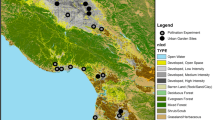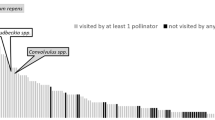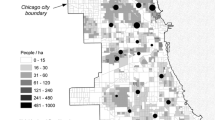Abstract
Plantings in residential neighborhoods can support wild pollinators. However, it is unknown how effectively wild pollinators maintain pollination services in small, urban gardens with diverse floral resources. We used a ‘mobile garden’ experimental design, whereby potted plants of cucumber, eggplant, and purple coneflower were brought to 30 residential yards in Chicago, IL, USA, to enable direct assessment of pollination services provided by wild pollinator communities. We measured fruit and seed set and investigated the effect of within-yard characteristics and adjacent floral resources on plant pollination. Increased pollinator visitation and taxonomic richness generally led to increases in fruit and seed set for all focal plants. Furthermore, fruit and seed set were correlated across the three species, suggesting that pollination services vary across the landscape in ways that are consistent among different plant species. Plant species varied in terms of which pollinator groups provided the most visits and benefit for pollination. Cucumber pollination was linked to visitation by small sweat bees (Lasioglossum spp.), whereas eggplant pollination was linked to visits by bumble bees. Purple coneflower was visited by the most diverse group of pollinators and, perhaps due to this phenomenon, was more effectively pollinated in florally-rich gardens. Our results demonstrate how a diversity of wild bees supports pollination of multiple plant species, highlighting the importance of pollinator conservation within cities. Non-crop resources should continue to be planted in urban gardens, as these resources have a neutral and potentially positive effect on crop pollination.


Similar content being viewed by others
References
Abak K, Sari N, Paksoy M, Kaftanoglu O, Yeninar H (1995) Efficiency of bumble bees on the yield and quality of eggplant and tomato grown in unheated greenhouses. Acta Hortic 412:268–274
Ahrne K, Bengtsson J, Elmqvist T (2009) Bumble bees (Bombus spp.) along a gradient of increasing urbanization. PLoS ONE 4:e5574. doi:10.1371/journal.pone.0005574
Baldock KCR, Goddard MA, Hicks DM, Kunin WE, Mitschunas N, Osgathorpe LM et al. (2015) Where is the UK’s pollinator biodiversity? The importance of urban areas for flower visiting insects. Proc R Soc Lond B doi:10.1098/rspb.2014.2849(in press)
Banaszak-Cibicka W, Zmihroski M (2011) Wild bees along an urban gradient: winners and losers. J Insect Conserv 16:331–343. doi:10.1007/s10841-011-9419-2
Bolund P, Hunhammar S (1999) Ecosystem services in urban areas. Ecol Econ 29:293–301
Cane JH, Minckley RL, Kervin LJ, Roulston TH, Williams NM (2006) Complex responses within a desert bee guild (Hymenoptera:Apiformes) to urban habitat fragmentation. Ecol Appl 16:632–644
Cariveau DP, Williams NM, Benjamin FE, Winfree R (2013) Response diversity to land use occurs but does not consistently stabilize ecosystem services provided by native pollinators. Ecol Lett 16:903–911. doi:10.1111/ele.12126
Carper AL, Adler LS, Warren PS, Irwin RE (2014) Effects of suburbanization on bee communities. Environ Entomol 43:253–262. doi:10.1603/EN13078
Chagnon M, Gingras J, Oliveira D (1993) Complementary aspects of strawberry pollination by honey and indigenous bees (Hymenoptera). J Econ Entomol 86:416–420
Cheptou PO, Avendano LG (2006) Pollination processes and the Allee effect in highly fragmented populations: consequences for the mating system in urban environments. New Phytol 172:774–783. doi:10.1111/j.1469-8137.2006.01880.x
Cussans J, Goulson D, Sanderson R, Goffe L, Darvill B, Osborne JL (2010) Two bee-pollinated plant species show higher seed production in gardens compared to arable farmland. PLoS ONE 5:e11753. doi:10.1371/journal.pone.0011753
Fetridge ED, Ascher JS, Langellotto GA (2008) The bee fauna of residential gardens in a suburb of New York City (Hymenoptera: Apoidea). Ann Entomol Soc Am 101:1067–1077. doi:10.1603/0013-8746-101.6.1067
Fontaine C, Dajoz I, Meriguet J, Loreau M (2005) Functional diversity of plant–pollinator interaction webs enhances persistence of plant communities. PLoS Biol 4:e1. doi:10.1371/journal.pbio.0040001
Fortel L, Henry M, Guilbaud L, Guirao AL, Kuhlmann M, Mouret H, Rollin O, Vaissiere BE (2014) Decreasing abundance, increasing diversity and changing structure of the wild bee community (Hymenoptera: Anthophila) along an urbanization gradient. PLoS ONE 9:e104679. doi:10.1371/journal.pone.0104679
Frankie GW, Thorp RW, Schindler M, Hernandez J, Ertter B, Rizzardi M (2005) Ecological patterns of bees and their host ornamental flowers in two Northern California cities. J Kansas Entomol Soc 78:227–246
Free JB (1993) Insect pollination of crops, 2nd edn. Academic, London
Garibaldi LA, Steffan-Dewenter I, Kremen C, Morales J, Bommarco R, Carvalheiro LG et al (2011) Stability of pollination services decreases with isolation from natural areas despite honey bee visits. Ecol Lett 14:1062–1072. doi:10.1111/j.1461-0248.2011.01669.x
Garibaldi LA, Steffan-Dewenter I, Winfree R, Aizen MA, Bommarco R, Cunningham SA et al (2013) Wild pollinators enhance fruit set of crops regardless of honey bee abundance. Science 339:1608–1611. doi:10.1126/science.1230200
Ghazoul J (2006) Floral diversity and the facilitation of pollination. J Ecol 94:295–304. doi:10.1111/j.1365-2745.2006.01098.x
Goulson D, Hughes W, Derwent L, Stout J (2002) Colony growth of the bumblebee, Bombus terrestris, in improved and conventional agricultural and suburban habitats. Oecologia 130:267–273. doi:10.1007/s004420100803
Hennig EI, Ghazoul J (2011) Plant-pollinator interactions within the urban environment. Perspect Plant Ecol 13:137–150. doi:10.1016/j.ppees.2011.03.003
Hoehn P, Tscharntke T, Tylianakis JM, Steffan-Dewenter I (2008) Functional group diversity of bee pollinators increases crop yield. Proc R Soc Lond B 275:2283–2291. doi:10.1098/rspb.2008.0405
Hooper DU, Chapin FS III, Ewel JJ, Hector A, Inchausti P, Lavorel S et al (2005) Effects of biodiversity on ecosystem functioning: A consensus of current knowledge. Ecol Monogr 75:3–35. doi:10.1890/04-0922
Kauffeld NM, Williams PH (1972) Honey bees as pollinators of pickling cucumber in Wisconsin. Am Bee J 112:252–254
Klein AM, Steffan-Dewenter I, Tscharntke T (2003) Fruit set of highland coffee increases with the diversity of pollinating bees. Proc R Soc Lond B 270:955–961. doi:10.1098/rspb.2002.2306
Klein AM, Vaissiere BE, Cane JH, Steffan-Dewenter I, Cunningham SA, Kremen C, Tscharntke T (2007) Importance of pollinators in changing landscapes for world crops. Proc R Soc Lond B 274:303–313. doi:10.1098/rspb.2006.3721
Kremen C, Williams NM, Aizen MA, Gemmill-Herren B, LeBuhn G, Minckley R et al (2007) Pollination and other ecosystem services produced by mobile organisms: a conceptual framework for the effects of land-use change. Ecol Lett 10:299–314. doi:10.1111/j.1461-0248.2007.01018.x
Ksiazek K, Fant J, Skogen K (2012) An assessment of pollen limitations on Chicago green roofs. Landsc Urban Plan 107:401–408. doi:10.1016/j.landurbplan.2012.07.008
Kwak MM, Velterop O, van Andel J (1998) Pollen and gene flow in fragmented habitats. Appl Veg Sci 1:37–54
Leong M, Kremen C, Roderick GK (2014) Pollinator interactions with yellow starthistle (Centaurea solstitialis) across urban, agricultural, and natural landscapes. PLoS ONE 9:e86357. doi:10.1371/journal.pone.0086357
Lowenstein DM, Huseth AS, Groves RL (2012) Response of wild bees to surrounding land cover in pickling cucumber. Environ Entomol 41:532–540. doi:10.1603/EN11241
Lowenstein DM, Matteson KC, Xiao I, Silva AM, Minor ES (2014) Human, bees, and pollination services in the city: the case of Chicago, IL (USA). Biodivers Conserv 23:2857–2874. doi:10.1007/s10531-014-0752-0
Luck GW, Smallbone LT, O’Brien R (2009) Socio-economics and vegetation change in urban ecosystems: patterns in space and time. Ecosystems 12:604–620. doi:10.1007/s10021-009-9244-6
Mallinger R, Gratton C (2015) Species richness of wild bees, but not the use of managed honey bees, increases fruit set of a managed crop. J Appl Ecol 52:323–330. doi:10.1111/1365-2664.12377
Matteson KC, Langellotto GA (2009) Bumble bee abundance in New York city community gardens: implications for urban agriculture. Cities Environ 2(1):5
Matteson KM, Ascher JS, Langellotto GA (2008) Bee richness and abundance in New York City Community Gardens. Ann Entomol Soc Am 101:140–150
Mazerolle M (2013) AICcmodavg: Model selection and multimodel inference based on (Q)AIC(c) http://CRAN.R-project.org/package=AICcmodavg
McCune B, Mefford MJ (2011) PC-ORD. Multivariate analysis of ecological data. Version 6.0. MjM software, Gleneden Beach, Oregon
McIntyre NE, Hostetler ME (2001) Effects of urban land use on pollinator communities in a desert metropolis. Basic Appl Ecol 2:209–218. doi:10.1078/1439-1791-00051
McKinney ML (2008) Effects of urbanization on species richness: a review of plants and animals. Urban Ecosyst 11:161–176. doi:10.1007/s11252-007-0045-4
Medrano M, Guitian P, Guitian P (2009) Patterns of fruit and seed set within inflorescences of Pancratium maritimum (Amaryllidaceae): nonuniform pollination, resource limitation, or architectural effects? Am J Bot 87:493–501
Mielke PW (1991) The application of multivariate permutation methods based on distance functions in the earth sciences. Earth-Sci Rev 31:55–71
Moeller DA (2004) Facilitative interactions among plants via shared pollinators. Ecology 85:3289–3301. doi:10.1890/03-0810
Naeem S (1998) Species redundancy and ecosystem reliability. Conserv Biol 12:39–45. doi:10.1111/j.1523-1739.1998.96379.x
Nassauer JI, Wang Z, Dayrell E (2009) What will the neighbors think? Cultural norms and ecological design. Landsc Urban Plan 92:282–292. doi:10.1016/j.landurbplan.2009.05.010
Ne’eman G, Jurgens A, Newstrom-Lloyd L, Potts SG, Dafni A (2010) A framework for comparing pollinator performance: effectiveness and efficiency. Biol Rev 85:435–451. doi:10.1111/j.1469-185X.2009.00108.x
Osborne JL, Martin AP, Shortall CR, Todd AD, Goulson D, Knight ME, Hale RJ, Sanderson RA (2008) Quantifying and comparing bumblebee nest densities in gardens and countryside habitats. J Appl Ecol 45:784–792. doi:10.1111/j.1365-2664.2007.01359.x
Pellissier V, Muratet A, Verfaillie F, Machon N (2012) Pollination success of Lotus corniculatus (L.) in an urban context. Acta Oecol 39:94–100. doi:10.1016/j.actao.2012.01.008
Potter A, LeBuhn G (2015) Pollination service to urban agriculture in San Francisco, CA. Urban Ecosystems. doi: 10.1007/s11252-015-0435-y (in press)
R Development Core Team R (2012) R: A language and environment for statistical computing. R Foundation of Statistical Computing, Vienna
Rader R, Howlett BG, Cunningham SA, Westcott DA, Newstrom-Lloyd LE, Walker MK et al (2009) Alternative pollinator taxa are equally efficient but not as effective as the honey bee in a mass flowering crop. J Appl Ecol 46:1080–1087. doi:10.1111/j.1365-2664.2009.01700.x
Rao GR (1980) Floral biology of Solanum melongena. New Bot 7:15–21
Ricketts TH, Regetz J, Steffan-Dewenter I, Cunningham SA, Kremen C, Bogdanski A et al (2008) Landscape patterns on crop pollination services: are there general patterns? Ecol Lett 11:499–515. doi:10.1111/j.1461-0248.2008.01157.x
Samnegard U, Persson AS, Smith HG (2011) Gardens benefit bees and enhance pollination in intensively managed farmland. Biol Conserv 144:2602–2606. doi:10.1016/j.biocon.2011.07.008
Seifan M, Hoch EM, Hanoteaux S, Tielbörger K (2014) The outcome of shared pollination services is affected by the density and spatial pattern of an attractive neighbour. J Ecol 102:953–962. doi:10.1111/1365-2745.12256
Seto K, Güneralp B, Hutyra LR (2012) Global forecasts of urban expansion to 2030 and direct impacts on biodiversity and carbon pools. Proc Natl Acad Sci USA 109:16083–16088. doi:10.1073/pnas.1211658109
Stanghellini MS, Ambrose JT, Schultheis JR (1997) The effects of honey bee and bumble bee pollination on fruit set and abortion of cucumber and watermelon. Am Bee J 137:386–391
Taylor JR, Lovell ST (2012) Mapping public and private spaces of urban agriculture in Chicago through the analysis of high-resolution aerial images in google earth. Landsc Urban Plan 108:57–70. doi:10.1016/j.landurbplan.2012.08.001
Thebo AL, Drechsel P, Lambdin EF (2014) Global assessment of urban and peri-urban agriculture: irrigated and rainfed croplands. Environ Res Lett 9:114002. doi:10.1088/1748-9326/9/11/114002
Tichý L, Chytrý M (2006) Statistical determination of diagnostic species for site groups of unequal size. J Veg Sci 17:809–818. doi:10.1111/j.1654-1103.2006.tb02504.x
Tilman D, Reich PB, Knops JMH (2006) Biodiversity and ecosystem stability in a decade-long grassland experiment. Nature 441:629–632. doi:10.1038/nature04742
Vázquez DP, Morris WF, Jordano P (2005) Interaction frequency as a surrogate for the total effect of animal mutualists on plants. Ecol Lett 8:1088–1094. doi:10.1111/j.1461-0248.2005.00810.x
Verboven HAF, Wim A, Brys R, Hermy M (2014) Pollination and seed set of an obligatory outcrossing plant in an urban-peri-urban gradient. Perspect Plant Ecol 16:121–131. doi:10.1016/j.ppees.2014.03.002
Wagenius S (2004) Style persistence, pollen limitation, and seed set in the common prairie plant Echinacea angustifolia (Asteraceae). Int J Plant Sci 165:595–603
Waters SM, Fisher SE, Hille Ris Lambers J (2014) Neighborhood-contingent indirect interactions between native and exotic plants: multiple shared pollinators mediate reproductive success during invasions. Oikos 123:433–440. doi:10.1111/j.1600-0706.2013.00643.x
Werrell PA, Langellotto GA, Morath SU, Matteson KC (2009) The influence of garden size and floral cover on pollen deposition in urban community gardens. Cities Environ 2:6
Williams NM, Winfree R (2013) Local habitat characteristics but not landscape urbanization drive pollinator visitation and native plant pollination in forest remnants. Biol Conserv 160:10–18. doi:10.1016/j.biocon.2012.12.035
Acknowledgments
The authors thank our crew of dedicated field assistants, Dragan Dragas, Sophie Huang, Tabitha Paroongsup, and Kay Lowenstein. The authors also thank the staff at the UIC Greenhouse and Lucas von Der Linden for their efforts at keeping plants healthy and preparing plants for field research. Finally, the authors thank the 30 participating homeowners in Chicago, IL, USA, for offering access to private spaces and caring for the mobile garden while in their yards. This work was funded by NSF Proposal Number: DEB-1120376.
Author contribution statement
DML collected the data and performed most analyses. DML, KCM, and ESM conceived and designed the experiments. DML, KCM, and ESM wrote the manuscript.
Author information
Authors and Affiliations
Corresponding author
Ethics declarations
Ethical approval
All applicable institutional and/or national guidelines for the care and use of animals were followed. All procedures performed in studies involving human participants were in accordance with the ethical standards of the institutional and/or national research committee and with the 1964 Helsinki declaration and its later amendments or comparable ethical standards.
Additional information
Communicated by Richard Karban.
Electronic supplementary material
Below is the link to the electronic supplementary material.
Rights and permissions
About this article
Cite this article
Lowenstein, D.M., Matteson, K.C. & Minor, E.S. Diversity of wild bees supports pollination services in an urbanized landscape. Oecologia 179, 811–821 (2015). https://doi.org/10.1007/s00442-015-3389-0
Received:
Accepted:
Published:
Issue Date:
DOI: https://doi.org/10.1007/s00442-015-3389-0




